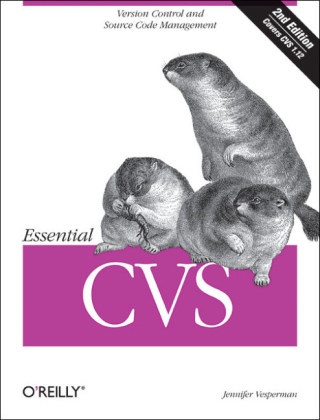Share
Fr. 60.50
Jennifer Vesperman, Vesperman Jennifer
Essentials CVS - Version Control and Source Code Management. Covers CVS 1.12
English · Paperback / Softback
Shipping usually within 3 to 5 weeks
Description
This easy-to-follow reference shows a variety of professionals how to use the Concurrent Versions System (CVS), the open source tool that lets you manage versions of anything stored in files. Ideal for software developers tracking different versions of the same code, this new edition has been expanded to explain common usages of CVS for system administrators, project managers, software architects, user-interface (UI) specialists, graphic designers and others.Current for version 1.12, Essential CVS, 2nd Edition offers an overview of CVS, explains the core concepts, and describes the commands that most people use on a day-to-day basis. For those who need to get up to speed rapidly, the book'sQuickstart Guide shows you how to build and use a basic CVS repository with the default settings and a minimum of extras. You'll also find: A full command reference that details all aspects of customizing CVS for automation, logging, branching, merging documents, and creating alerts Examples and descriptions of the most commonly used options for each command Why and when to tag or branch your project, tagging before releases, and using branching to create a bugfix version of a project Details on the systems used in CVS to permit multiple developers to work on the same project without loss of dataAn entire section devoted to document version management and project management includes ways to import and export projects, work with remote repositories, and shows how to fix things that can go wrong when using CVS. You'll find more screenshots in this edition as well as examples of using graphical CVS clients to run CVS commands. Essential CVS also includes a FAQ that answers common queries in the CVS mailing list to get you up and running with this system quickly and painlessly.
List of contents
Inhaltsverzeichnis
Preface
Part I. Introduction
1. What Is CVS?
What Is a Versioning System?
Why CVS?
CVS in the Field
2. CVS Quickstart Guide
Installing CVS
Building Your First Repository
Importing Projects
Accessing Remote Repositories
Checking Out Files
Editing Files
Committing Changes
Updating Sandboxes
Adding Files
Removing Files
Exporting and Building Projects
Quick Tips for Success
Part II. Using CVS
3. Basic Use of CVS
General Information
Sandboxes and Repositories
Committing Changes to the Repository
Updating the Sandbox Files from the Repository
Adding Files to the Repository
Removing Files from the Repository
Moving Files or Directories
Releasing a Sandbox
Keywords
Binary Files and Wrappers
Specifying Default Command Options
4. Tagging and Branching
Tagging
Stickiness
Branching
Branching Strategies
Merging Strategies
5. Multiple Users
Using Simultaneous Development
Watching a File
Reserving Files
Comparing File Revisions
Displaying Recent Changes
Displaying File History
Part III. CVS Administration
6. Repository Management
Creating a Repository
Deleting a Repository
Securing Your Projects
Repository Structure
CVSROOT Files
Server Environment Variables
Backing Up a Repository
Distributed Repositories
Editing a Repository
Sandbox Structure
Client Environment Variables
Exit Status
7. Project Management
Creating a Project
Distributing Files
Running Scripts
Interfacing with External Programs
Tools
Strategies and Practices
8. Remote Repositories
Specifying Repository Paths
Method Options
The local Access Method
The ext and server Access Methods
The fork Access Method
The gserver Access Method
The kserver Access Method
The pserver Access Method
Using inetd with gserver, kserver, and pserver
PAM
9. Troubleshooting
General Troubleshooting Techniques
Connectivity Problems
Filename Problems
Line-Ending Problems
Permission Problems
Lock Files
Time Issues
Part IV. Reference
10. Command Reference
CVS Command-Line Options
CVS Commands
11. Miscellaneous Topics Reference
Administrative Files
CVSROOT Files
CVSROOT Variables
Dates
Environment Variables
Keywords and Keyword Modes
Pattern Matching
Repository Access Methods
Part V. Appendixes
A. Clients and Operating Systems
B. Administrators' Tools
C. Frequently Asked Questions
Index
About the author
Summary
Shows professionals how to use the Concurrent Versions System (CVS), the open source tool that lets you manage versions of anything stored in files. Intended for software developers tracking different versions of the same code, this edition offers an overview of CVS, explains the core concepts, and describes its commands.
Product details
| Authors | Jennifer Vesperman, Vesperman Jennifer |
| Publisher | O'Reilly Media |
| Languages | English |
| Product format | Paperback / Softback |
| Released | 01.01.2006 |
| EAN | 9780596527037 |
| ISBN | 978-0-596-52703-7 |
| No. of pages | 428 |
| Weight | 694 g |
| Illustrations | w. figs. |
| Series |
Essentials Ser. |
| Subjects |
Natural sciences, medicine, IT, technology
> IT, data processing
> IT
COMPUTERS / Operating Systems / General, Operating systems |
Customer reviews
No reviews have been written for this item yet. Write the first review and be helpful to other users when they decide on a purchase.
Write a review
Thumbs up or thumbs down? Write your own review.

